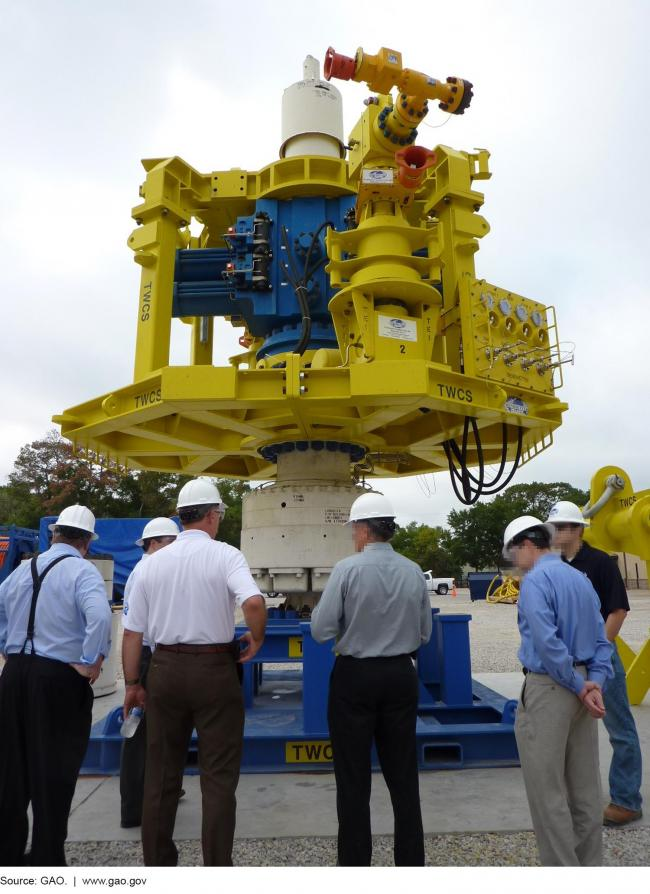Offshore Oil and Gas Oversight: Actions Needed to Address Leadership Commitment Deficiencies at Interior
Fast Facts
Effective oversight of offshore oil and gas development is critical to preventing another Deepwater Horizon-type disaster.
However, the Department of the Interior's Bureau of Safety and Environmental Enforcement has struggled to successfully implement key initiatives to improve offshore oversight. For example, a risk-based facility inspection initiative was halted due to concerns about its usefulness and unclear protocols.
This and other difficulties are largely due to insufficient coordination and leadership commitment. In turn, we recommended that Interior take steps to improve the bureau's coordination and leadership commitment.
A Capping Stack
In an earlier version, the capping stack was incorrectly referred to as a blowout preventer. A capping stack caps a well after a blowout to stop the uncontrolled flow of oil.

Photo of a blowout preventer
Highlights
What GAO Found
The Department of the Interior's (Interior) Bureau of Safety and Environmental Enforcement (BSEE) leadership has started several key strategic initiatives to improve its offshore safety and environmental oversight, but its limited efforts to obtain and incorporate input from within the bureau have hindered its progress. For example, to supplement its mandatory annual regulatory compliance inspections, in 2012, BSEE leadership began developing a risk-based inspection initiative to identify high-risk production facilities and assess their safety systems and management controls. During pilot testing in 2016, several deficiencies--including the usefulness of its facility risk-assessment model and unclear inspection protocols--caused BSEE to halt the pilot. According to bureau officials, during the development of the initiative, BSEE headquarters did not effectively obtain and incorporate input from regional personnel with long-standing experience in previous risk-based inspection efforts, who could have identified deficiencies earlier in the process. GAO previously found that when implementing large-scale management initiatives a key practice is involving employees to obtain their ideas by incorporating their feedback into new policies and procedures. Instead, BSEE leadership appears to have excluded the input of regional personnel by, for example, not incorporating input beyond the risk-assessment tool when selecting the first pilot facility, even though it was prescribed to do so in the bureau's inspection planning methodology. This undercut the pilot effort, raising questions about whether the bureau's leadership has the commitment necessary to successfully implement its risk-based program. Without higher level leadership within Interior establishing a mechanism for BSEE to obtain and incorporate input from personnel within the bureau, BSEE's risk-based inspection initiative could face continued delays.
Similarly, since 2013, BSEE leadership has started several key strategic initiatives to improve its internal management, but none have been successfully implemented, in part, because of limited leadership commitment. For example, BSEE's leadership identified the importance of developing performance measures in its 2012-2015 strategic plan. BSEE began one of three attempts to develop performance measures in July 2014 by hiring a contractor to develop measures, but the bureau terminated this contract in January 2015 after determining a need to complete its internal reorganization before developing such measures. A second effort to develop performance measures started in December 2015, using the same consultant, and yielded 12 performance measures in March 2016, but BSEE did not implement them, in part, because data did not exist to use the measures. By the time BSEE received this consultant's report, it had already begun a third effort to internally develop performance measures; as of November 2016 had identified 17 draft performance measures, but BSEE leadership missed repeated deadlines to review them. BSEE officials told GAO that after leadership approval, the bureau plans to pilot these measures and develop others. BSEE leadership has not demonstrated continuing oversight and accountability for implementing internal management initiatives, as evidenced by its limited progress implementing key strategic initiatives. Without higher-level oversight within Interior addressing leadership commitment deficiencies within BSEE, the bureau is unlikely to succeed in implementing internal management initiatives.
Why GAO Did This Study
This testimony summarizes the information contained in GAO's March 2017 report, entitled Oil and Gas Management: Stronger Leadership Commitment Needed at Interior to Improve Offshore Oversight and Internal Management (GAO-17-293).
For more information, contact Frank Rusco at (202) 512-3841 or ruscof@gao.gov.
